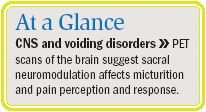Article
Sacral neuromodulation affects central nervous system
A new study has produced solid evidence that sacral neuromodulation affects the central nervous system.

UCLA urologists have used sacral neuromodulation since 1997 to treat frequency, urgency, urge incontinence, retention, and, recently, painful bladder syndrome.
"But we don't know how it works, what the mechanism of action might be. This helps us understand a little better how neuromodulation works," lead author and resident Nasim Zabihi, MD, said at the AUA annual meeting.
"But with EEGs, it is very difficult to delineate the anatomical location where these cortical-potentials originate," Dr. Zabihi said. "PET scans are used to evaluate brain function in more detail."
Nine patients who had sacral neuromodulators implanted for at least 6 months were given two series of four PET scans, lasting about 2 minutes each. Each patient received a total of eight PET scans performed in two series of four scans: one with the modulator off; one in an anticipatory mode when the patient thought the modulator was on, but it was not; one in a high-intensity mode that allowed the patients to feel sensations typically associated with sacral neuromodulation; and one with the modulators in a low-intensity mode that was below each patient's threshold of sensation.
The first two states (stimulator off and expecting stimulation) served as controls. The four scan states were varied to control for any order effect.
Radiolabeled water was used to quantify blood flow in different areas in the brain. Because blood flow in the brain increases in direct proportion to increases in synaptic activity, any changes in blood flow would indicate increases or decreases in neural activity. Changes in neural activity could be measured relative to the two control states and localized to specific anatomic structures within the brain.
Scans showed that high levels of sacral neurostimulation were significantly associated with decreased activity in the left dorsal anterior cingulate cortex (ACC) without persistence of this effect during low-level stimulation, Dr. Zabihi said. The left dorsal ACC is linked to perceptions of noxious or painful stimuli. Down-regulating this area could lessen perceptions of pain, urgency, or other unpleasant sensations associated with voiding disorders.
High-level stimulation was also associated with increased activity in the pons, the right hippocampus, and the perigenual ACC. Low-level stimulation was also associated with increased perigenual ACC activity. The pons and hippocampus are both linked with micturition, Dr Zabihi said. The perigenual ACC is linked with descending pain inhibitory pathways. Up-regulating this area could affect perceptions of pain or other unpleasant sensations.
"It seems that sacral neuromodulation affects the areas of the brain that not only control micturition, but also areas of the brain that are associated with learning behavior and with the perception of noxious or painful stimuli," she said.
The study was funded by a grant from Medtronic.





